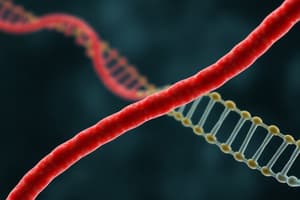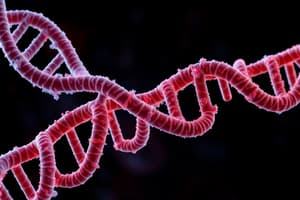Podcast
Questions and Answers
Hvilket av følgende utsagn beskriver best formålet med hypotesetesting?
Hvilket av følgende utsagn beskriver best formålet med hypotesetesting?
- Å finne den sanne verdien av populasjonsparameteren.
- Å avgjøre om det er nok bevis til å forkaste nullhypotesen. (correct)
- Å beregne nøyaktig sannsynlighet for at nullhypotesen er sann.
- Å bevise at nullhypotesen er sann.
I hypotesetesting, hva representerer signifikansnivået (α)?
I hypotesetesting, hva representerer signifikansnivået (α)?
- Sannsynligheten for å akseptere nullhypotesen når den er sann.
- Sannsynligheten for å gjøre en type II-feil.
- Sannsynligheten for å forkaste nullhypotesen når den faktisk er sann. (correct)
- Sannsynligheten for å akseptere nullhypotesen når den er usann.
Hva er forskjellen på en ensidig og en tosidig hypotesetest?
Hva er forskjellen på en ensidig og en tosidig hypotesetest?
- Tosidig test brukes kun når vi ikke har noen nullhypotese.
- Ensidig test er mer nøyaktig enn tosidig test.
- Ensidig test tester for en effekt i én bestemt retning, mens tosidig tester for effekt i begge retninger. (correct)
- Ensidig test brukes når utvalgsstørrelsen er liten, mens tosidig brukes når utvalgsstørrelsen er stor.
Hvilken av følgende faktorer vil øke styrken til en hypotesetest?
Hvilken av følgende faktorer vil øke styrken til en hypotesetest?
I en studie sammenlignes to grupper ved hjelp av en t-test. Resultatet viser en p-verdi på 0.03, og signifikansnivået er satt til 0.05. Hvilken konklusjon kan trekkes?
I en studie sammenlignes to grupper ved hjelp av en t-test. Resultatet viser en p-verdi på 0.03, og signifikansnivået er satt til 0.05. Hvilken konklusjon kan trekkes?
Flashcards
Hva er et objekt?
Hva er et objekt?
Et sett av data og metoder som opererer på disse dataene.
Hva er en klasse?
Hva er en klasse?
En 'blåkopi' eller mal for å lage objekter.
Hva er innkapsling?
Hva er innkapsling?
Å skjule interne detaljer og bare eksponere nødvendig funksjonalitet.
Hva er arv?
Hva er arv?
Signup and view all the flashcards
Hva er polymorfisme?
Hva er polymorfisme?
Signup and view all the flashcards
Study Notes
- Gene expression is the process by which information from a gene is used in the synthesis of a functional gene product
- These products are often proteins, but can also be functional RNA molecules like tRNA or rRNA
- Gene expression is a tightly regulated process that allows a cell to respond to its changing environment
- Gene expression also allows cells to specialize, with different cell types expressing different sets of genes
- The central dogma of molecular biology describes the flow of genetic information within a biological system
- DNA is transcribed into RNA, which is then translated into protein
- Not all genes are protein-coding genes; some genes encode functional RNA molecules
Transcription
- Transcription is the process of synthesizing RNA from a DNA template
- It is carried out by an enzyme called RNA polymerase
- In eukaryotes, transcription occurs in the nucleus
- The basic steps of transcription are initiation, elongation, and termination
Initiation
- RNA polymerase binds to a specific DNA sequence called the promoter
- The promoter contains specific sequences that help RNA polymerase bind
- In eukaryotes, transcription factors mediate the binding of RNA polymerase to the promoter, thus initiating transcription
Elongation
- RNA polymerase moves along the DNA template, unwinding the DNA double helix
- RNA polymerase adds nucleotides to the 3' end of the growing RNA molecule
- The sequence of the RNA molecule is complementary to the DNA template strand
Termination
- Transcription continues until RNA polymerase reaches a terminator sequence
- In eukaryotes, the RNA molecule is released from the DNA template and undergoes processing, specifically a 5' cap and a 3' poly-A tail are added
RNA Processing in Eukaryotes
- Eukaryotic pre-mRNA molecules are processed in the nucleus to produce mature mRNA molecules
- RNA processing includes:
- Addition of a 5' cap
- Addition of a 3' poly-A tail
- RNA splicing
5' Cap and 3' Poly-A Tail
- The 5' cap is a modified guanine nucleotide added to the 5' end of the pre-mRNA molecule
- The 5' cap protects the mRNA from degradation and helps it bind to ribosomes
- The 3' poly-A tail is a string of adenine nucleotides added to the 3' end of the pre-mRNA molecule
- The 3' poly-A tail also protects the mRNA from degradation and helps it bind to ribosomes
RNA Splicing
- RNA splicing is the process of removing introns from the pre-mRNA molecule and joining together the exons
- Introns are non-coding regions of the pre-mRNA molecule
- Exons are the coding regions of the pre-mRNA molecule
- RNA splicing is carried out by a complex called the spliceosome which is composed of proteins and small RNAs
Translation
- Translation is the process of synthesizing a polypeptide from an mRNA template
- Translation occurs on ribosomes
- In eukaryotes, ribosomes are found in the cytoplasm and the rough endoplasmic reticulum but translation can also occur in mitochondria and chloroplasts
Transfer RNA (tRNA)
- Transfer RNA (tRNA) molecules carry amino acids to the ribosome
- Each tRNA molecule has an anticodon that is complementary to a specific codon on the mRNA molecule
- Each tRNA molecule carries the amino acid specified by the codon to which it binds
Ribosomes
- Ribosomes are composed of two subunits: a large subunit and a small subunit
- Ribosomes have three binding sites for tRNA: the A site, the P site, and the E site
- The A site binds to the tRNA carrying the next amino acid to be added to the polypeptide chain
- The P site binds to the tRNA carrying the growing polypeptide chain
- The E site is the exit site, where tRNA molecules leave the ribosome
Translation - Initiation, Elongation, and Termination
- The basic steps of translation are initiation, elongation, and termination
Initiation
- The small ribosomal subunit binds to the mRNA molecule
- A tRNA molecule carrying methionine binds to the start codon (AUG) on the mRNA molecule
- The large ribosomal subunit binds to the small ribosomal subunit, forming the translation initiation complex
Elongation
- A tRNA molecule carrying the next amino acid binds to the A site on the ribosome
- A peptide bond forms between the amino acid in the A site and the growing polypeptide chain in the P site
- The ribosome moves down the mRNA molecule, shifting the tRNA in the A site to the P site and the tRNA in the P site to the E site
- The tRNA in the E site leaves the ribosome
- These steps are repeated until the ribosome reaches a stop codon
Termination
- When the ribosome reaches a stop codon (UAA, UAG, or UGA), a release factor binds to the A site
- The release factor causes the polypeptide chain to be released from the tRNA in the P site
- The ribosome dissociates into its large and small subunits
Protein Folding
- Protein folding is the physical process by which a polypeptide chain folds into its biologically active three-dimensional structure
- The amino acid sequence of a protein determines its three-dimensional structure
- Proteins fold spontaneously, but they are often assisted by chaperone proteins
- Chaperone proteins help proteins fold correctly and prevent them from aggregating
Eukaryotic vs. Prokaryotic Gene Expression
- Eukaryotic and prokaryotic gene expression differ in several ways
- In prokaryotes, transcription and translation occur in the cytoplasm
- In eukaryotes, transcription occurs in the nucleus and translation occurs in the cytoplasm
- Eukaryotic mRNA molecules are processed before translation, while prokaryotic mRNA molecules are not
- Eukaryotic genes contain introns, while prokaryotic genes do not
- Eukaryotic mRNA molecules have a 5' cap and a 3' poly-A tail, while prokaryotic mRNA molecules do not
Regulation of Gene Expression
- Gene expression is regulated at multiple levels
- Transcriptional control regulates the amount of RNA produced
- Post-transcriptional control regulates the processing and stability of RNA molecules
- Translational control regulates the amount of protein produced
- Post-translational control regulates the activity of proteins
Transcriptional Control
- Transcriptional control is the most common way to regulate gene expression
- Transcriptional control is mediated by transcription factors
- Transcription factors bind to specific DNA sequences and either activate or repress transcription
- Activators are transcription factors that increase the rate of transcription
- Repressors are transcription factors that decrease the rate of transcription
Post-Transcriptional Control
- Post-transcriptional control regulates the processing and stability of RNA molecules
- RNA processing includes:
- Addition of a 5' cap
- Addition of a 3' poly-A tail
- RNA splicing
- RNA stability is affected by:
- The length of the poly-A tail
- The presence of specific sequences in the mRNA molecule
- RNA-binding proteins
Translational Control
- Translational control regulates the amount of protein produced
- Translational control is mediated by:
- The availability of ribosomes
- The presence of specific sequences in the mRNA molecule
- RNA-binding proteins
- MicroRNAs (miRNAs)
Post-Translational Control
- Post-translational control regulates the activity of proteins
- Post-translational control is mediated by:
- Chemical modifications of the protein (e.g., phosphorylation, glycosylation)
- Protein folding
- Protein degradation
Mutations
- A mutation is a change in the nucleotide sequence of DNA
- Mutations can be spontaneous or induced by mutagens
- Mutagens are physical or chemical agents that cause mutations
Types of Mutations
- Point mutations are changes in a single nucleotide base
- Base-pair substitutions: replace one nucleotide base with another
- Insertions: add one or more nucleotide bases to a DNA sequence
- Deletions: remove one or more nucleotide bases from a DNA sequence
- Frameshift mutations are insertions or deletions that alter the reading frame of the mRNA
- Chromosomal mutations are changes in the structure or number of chromosomes
- Deletions: remove a portion of a chromosome
- Duplications: repeat a portion of a chromosome
- Inversions: reverse the order of a portion of a chromosome
- Translocations: move a portion of one chromosome to another chromosome
Effects of Mutations
- Mutations can have a variety of effects on gene expression and protein function with outcomes typically classified as harmful, neutral or beneficial
- Some mutations have no effect on gene expression or protein function (silent mutations) due to redundancy in the genetic code
- Other mutations can alter gene expression or protein function in a way that is harmful to the organism
- Rarely, mutations improve gene expression or protein function in a way that is beneficial to the organism
Causes of Mutations
- Mutations can be caused by a variety of factors, including:
- Errors in DNA replication
- Exposure to mutagens
- Spontaneous mutations
Studying That Suits You
Use AI to generate personalized quizzes and flashcards to suit your learning preferences.




